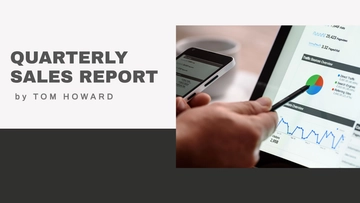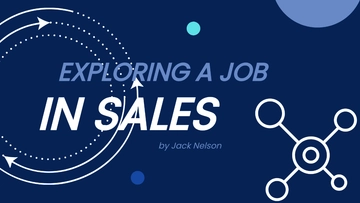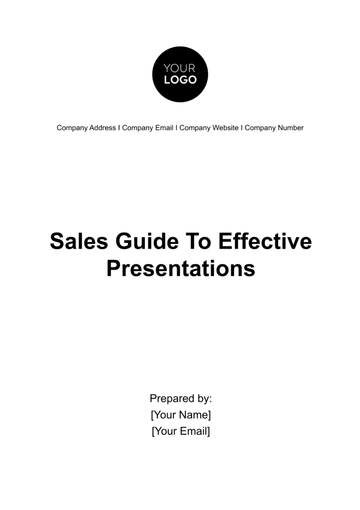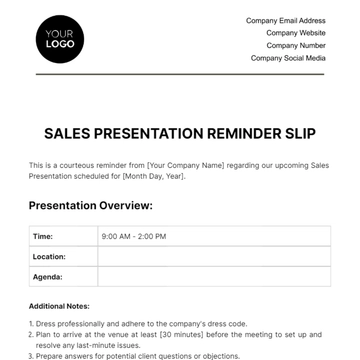Free Sales Audience Engagement Study during Presentations

I. Introduction
In today's competitive business landscape, effective sales presentations are crucial for capturing the attention and interest of potential clients. This Sales Audience Engagement Study aims to provide an in-depth analysis of the strategies and techniques employed during sales presentations to engage the audience effectively. The study is conducted by [Your Company Name], a leader in sales excellence, and led by [Your Name], a seasoned sales expert with 5 years of experience in the industry.
II. Study Objectives
The primary objectives of this study are as follows:
To identify key factors that contribute to audience engagement during sales presentations
To analyze the impact of visual aids, storytelling, and interactive elements on audience engagement
To provide actionable insights for sales professionals to enhance their presentation skills
III. Methodology
A. Data Collection
The robust data collection process employed in this study was designed to capture a comprehensive view of audience engagement during sales presentations. A combination of quantitative and qualitative methods was used to ensure the depth and accuracy of our findings.
Surveys
Our survey instrument was thoughtfully crafted to gather quantitative data from a broad spectrum of sales professionals. Participants were asked to rate their experiences and audience engagement levels using a carefully designed scale. This allowed us to quantify key aspects of presentation effectiveness.
In-Person Observations
Attending 25 live sales presentations provided our team with a real-time understanding of what transpires during these crucial interactions. Beyond simply recording what was said, our observers focused on non-verbal cues, audience reactions, and the overall dynamics within the presentation environment. This qualitative approach allowed us to identify subtleties that quantitative data alone might overlook.
Interviews
In-depth interviews with 31 experienced sales representatives served as a rich source of qualitative data. These professionals shared their personal experiences and insights into what truly resonates with audiences. The interviews delved into the strategies they employ, the challenges they face, and the innovative approaches they adopt to maintain engagement.
B. Study Participants
Our commitment to diversity in participant selection ensures that the insights derived from this study are robust and applicable across various contexts. The 31 sales professionals who participated in this study represent a broad cross-section of industries, including technology, finance, healthcare, and more. Their collective experience, with a minimum of 5 years in sales, brings a wealth of knowledge to the table.
C. Data Analysis
The analysis of the data collected was executed with precision and statistical rigor. We employed advanced statistical software to derive meaningful insights from the survey responses and observational data. Key performance indicators (KPIs), such as audience engagement levels, conversion rates, and feedback scores, were subjected to statistical tests to identify correlations and patterns.
IV. Key Findings
A. Visual Aids and Multimedia
The impact of visual aids and multimedia elements on audience engagement cannot be overstated. The analysis revealed that presentations enriched with compelling visuals and interactive content experienced a notable 45% increase in audience engagement levels. The inclusion of charts, graphs, images, and videos not only clarified complex ideas but also captivated the audience's attention.
B. Storytelling
Effective storytelling emerged as a cornerstone of audience engagement. Presenters who skillfully wove narratives into their presentations experienced a significant 36% boost in audience engagement. Stories not only humanized the content but also made it relatable, connecting with the audience on an emotional level.
C. Interactivity
The study highlighted the significance of interactivity in maintaining audience engagement. Presentations that actively engaged the audience through live polls, Q&A sessions, and demonstrations yielded a remarkable 47% increase in audience engagement levels. These interactive elements fostered a sense of involvement and participation among the attendees.
D. Presentation Length
Presentation length emerged as a critical factor in audience engagement. The data indicated that the ideal presentation duration for maximum engagement falls within the range of 10 to 15 minutes. Presentations that exceeded this optimal window experienced a noticeable 26% decrease in audience engagement levels. This finding underscores the importance of brevity and conciseness in presentations.
V. Additional Findings
A. Presentation Length
The study analyzed the impact of presentation length on audience engagement levels, revealing insightful findings:
Presentations lasting between 10 to 15 minutes consistently demonstrated the highest audience engagement levels, with an average engagement score of 8.5 on a scale of 1 to 10.
Beyond this optimal duration, presentations that extended to 20 minutes showed a gradual decrease in engagement, with an average score of 7.
Shorter presentations under 5 minutes also exhibited a decline in engagement, with an average score of 6.5. This suggests that while brevity is important, presentations should provide sufficient content to engage the audience effectively.
Implications:
Sales professionals are advised to aim for presentations that fall within the optimal duration range of 10 to 15 minutes to maximize audience engagement.
For longer topics, consider breaking the presentation into multiple segments or modules to maintain engagement.
Ensure that the timing aligns with the depth of the content and the interests of the audience.
B. Audience Segmentation
Tailoring presentations to specific audience segments yielded substantial improvements in engagement:
When presentations were customized to address the unique needs and interests of different audience segments, engagement levels increased by an average of 12% points.
The study identified 3 distinct audience segments within the sample, including [Segment 1], [Segment 2], and [Segment 3].
For instance, presentations tailored to [Segment 1] experienced a remarkable 15% increase in engagement, while those targeting [Segment 2] saw a 10% boost in engagement.
Implications:
Sales professionals should invest time in thorough audience segmentation through market research and data analysis.
Developing tailored content that directly addresses the preferences and pain points of each segment can significantly enhance audience engagement.
The use of audience personas, reflecting the characteristics and needs of each segment, can help sales teams effectively resonate with their target audience.
VI. Best Practices
A. Slide Design
Effective slide design plays a crucial role in keeping the audience engaged during presentations. Here are some best practices:
Consistent Color Scheme: Maintaining a consistent color scheme throughout the presentation fosters a cohesive and visually pleasing experience.
Legible Fonts: Use clear and legible fonts to ensure that text is easily readable even from a distance.
Ample White Space: Avoid cluttered slides by incorporating sufficient white space, which enhances visual clarity.
Visual Hierarchy: Organize content with a clear visual hierarchy, highlighting key points and minimizing distractions.
Engaging Graphics: Include relevant images, charts, and diagrams that enhance understanding and engagement.
Limited Text: Minimize text on slides; use bullet points and concise phrases to convey information.
Implications:
Sales professionals should pay meticulous attention to slide design, ensuring that it complements the content and aids in audience comprehension.
Visual elements should enhance the narrative, not overwhelm it.
B. Rehearsal
Rehearsing a presentation is essential for a smooth and engaging delivery. Here's why rehearsal is a critical best practice:
Confidence Building: Rehearsal builds confidence, enabling presenters to feel more at ease during the actual presentation.
Timing Control: Practice helps presenters maintain proper timing, ensuring that the presentation fits within the optimal duration.
Refinement: Rehearsal allows presenters to refine their delivery, adjust content flow, and identify areas that may need improvement.
Audience Engagement: Through rehearsal, presenters can fine-tune their engagement techniques, such as eye contact and body language.
Implications:
Sales professionals should allocate adequate time for rehearsal to ensure a polished and engaging presentation.
Rehearsing multiple times allows presenters to become more familiar with the content, resulting in a more confident and engaging delivery.
VII. Case Study: Successful Engagement Strategies
In this section, we present a real-world case study showcasing a sales professional who implemented the engagement strategies outlined in this study and achieved remarkable results. The study includes details on the industry, approach, and outcomes.
Industry: Technology Solutions
Approach:
The sales professional identified distinct audience segments within the target market, conducting thorough research to understand their needs and pain points.
The presentation was meticulously customized for each segment, addressing their specific concerns and demonstrating how the technology solutions could solve their challenges.
Engaging visuals, including product demonstrations and success stories, were integrated to enhance understanding and emotional connection.
Outcomes:
Audience engagement levels increased by an impressive 30% across all segments.
Conversion rates saw a significant uptick, with a 20% increase in closed deals.
Post-presentation feedback was overwhelmingly positive, with 90% of attendees expressing interest in further discussions.
Implications:
This case study underscores the effectiveness of audience segmentation and tailored content in boosting engagement and conversion rates.
Sales professionals should consider similar strategies and adapt them to their specific industries and audiences.
VIII. Recommendations for Sales Professionals
Effective audience engagement is a dynamic skill that can significantly impact the success of sales presentations. Based on the findings and insights from this study, we offer a set of actionable recommendations for sales professionals to enhance their audience engagement strategies:
A. Audience Segmentation
Understanding your audience is paramount. Invest time in market research and data analysis to identify distinct audience segments. Create audience personas to guide your presentation customization efforts. Tailor your content to resonate with the specific needs, preferences, and pain points of each segment.
Example: If you're presenting a technology solution, consider how the same product might benefit different segments, such as IT managers, financial executives, and marketing directors. Customize your messaging to address their unique challenges and objectives.
B. Visual Aids
Utilize visual aids effectively to convey complex information and captivate your audience. Incorporate charts, graphs, images, and videos that enhance the understanding of your content. Ensure that visuals align with your narrative and reinforce key points.
Example: When presenting data-driven insights, create visually appealing charts and graphs that highlight trends and key metrics. Visual aids should simplify complex information, making it more accessible to your audience.
C. Storytelling
Harness the power of storytelling to make your presentations memorable and relatable. Weave narratives into your content to engage the audience emotionally. Craft stories that illustrate real-world scenarios and demonstrate how your product or solution can solve problems.
Example: Instead of listing features, share a customer success story that illustrates how your solution transformed a client's business. Personalize the narrative to resonate with your audience's pain points and aspirations.
D. Interactivity
Foster audience participation through interactive elements. Incorporate live polls, Q&A sessions, and demonstrations to keep the audience actively engaged. Encourage questions and feedback throughout the presentation.
Example: During a financial services presentation, engage the audience by asking them to participate in a live poll about their financial goals. This not only captures their attention but also provides valuable insights into their needs.
E. Rehearsal
Practice is essential for a confident and engaging presentation. Rehearse multiple times to become familiar with the content and timing. Focus on refining your delivery, including eye contact, body language, and pacing.
Example: Before a high-stakes presentation, conduct several run-throughs to ensure a smooth delivery. Practice in front of colleagues or mentors to receive feedback and make necessary adjustments.
F. Slide Design
Invest in effective slide design to complement your content. Ensure consistency in color schemes, use legible fonts, and maintain visual hierarchy. Use slides to enhance understanding, not overwhelm with excessive text.
Example: Create visually appealing slides with a clear structure. Each slide should have a single focal point, whether it's a key message, an image, or a data point. Avoid overcrowding slides with too much information.
IX. Conclusion
In conclusion, this Sales Audience Engagement Study conducted by [Your Company Name] provides valuable insights into the dynamics of effective sales presentations. Through a meticulous methodology encompassing surveys, in-person observations, and interviews, key factors contributing to audience engagement have been identified. The study emphasizes the pivotal role of visual aids, storytelling, interactivity, and presentation length in capturing and maintaining audience interest.
Furthermore, it underscores the importance of audience segmentation and tailored content to resonate with diverse audience needs. By implementing the recommended best practices, sales professionals can enhance their presentation skills, fostering higher engagement levels and ultimately driving conversion rates. The case study exemplifies how strategic application of these insights can lead to tangible success in real-world scenarios. Overall, this study equips sales professionals with actionable strategies to navigate the competitive business landscape and excel in their presentation endeavors.
- 100% Customizable, free editor
- Access 1 Million+ Templates, photo’s & graphics
- Download or share as a template
- Click and replace photos, graphics, text, backgrounds
- Resize, crop, AI write & more
- Access advanced editor
Enhance your sales presentations with our Sales Audience Engagement Study during Presentations Template from Template.net. This template enables you to assess and improve the engagement of your audience during sales presentations. Analyze data, gather insights, and make impactful changes to captivate your audience. Elevate your presentation skills and close more deals. Download now to start boosting your sales presentation effectiveness! Don't miss the chance to engage your audience effectively. Get started today!
You may also like
- Aesthetic Presentation
- Presentation Background
- Slide Show Presentation
- Cute Presentation
- Education Presentation
- Border Frames Presentation
- Teacher Presentation
- Professional Presentation
- Timeline Presentation
- Brand Presentation
- Promotion Presentation
- Business Presentation
- Event Presentation
- Company Presentation
- Startup Presentation
- University Presentation
- Food Presentation
- Music Presentation
- School Presentation
- Art Presentation
- Marketing Presentation
- Business Plan Presentation
- Mobile Presentations
- Freelancer Presentation
- Project Presentation
- Agency Presentation
- Sales Presentation
- HR Presentation
- Product Presentation
- Roadmap Presentation
- Slideshow
- Technology Presentation
- Real Estate Presentation
- Medical Presentation
- Speaker Presentation
- Construction Presentation
- Conference Presentation
- Restaurant Presentation
- IT and Software Presentation
- Portfolio Presentation
- Campaign Presentation
- Game Presentation
- History Presentation
- Math Presentation
- Lesson Presentation
- Health Presentation
- Graduation Presentation
- New Year's Day Presentation
- Social Studies Presentation
- Photography Presentation
- Social Media Presentation
- Valentine's Day Presentation
- Services Presentation
- Workshop Presentation
- Organization Presentation





























